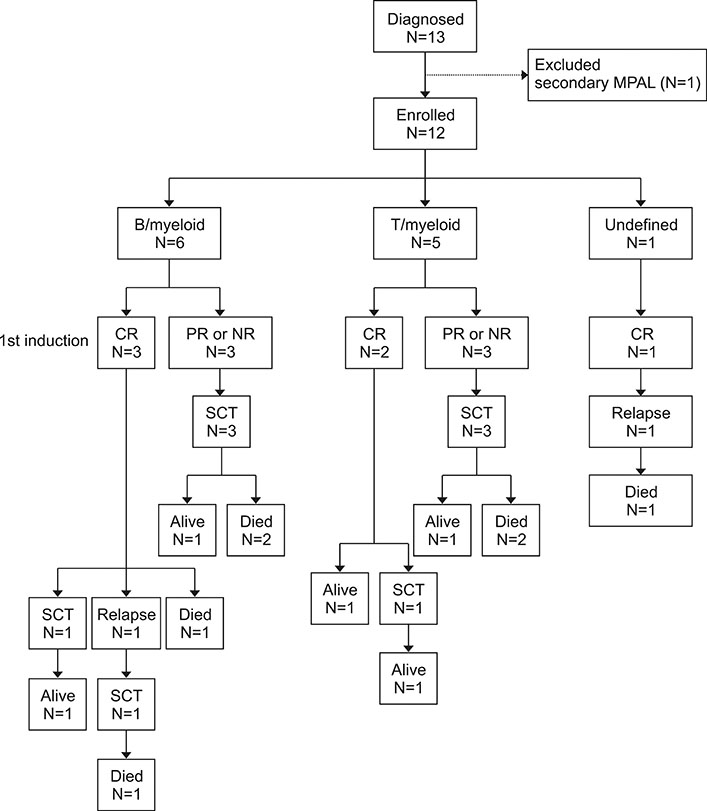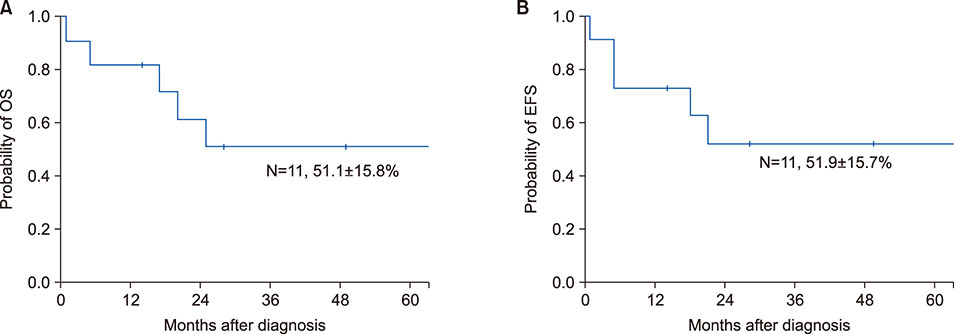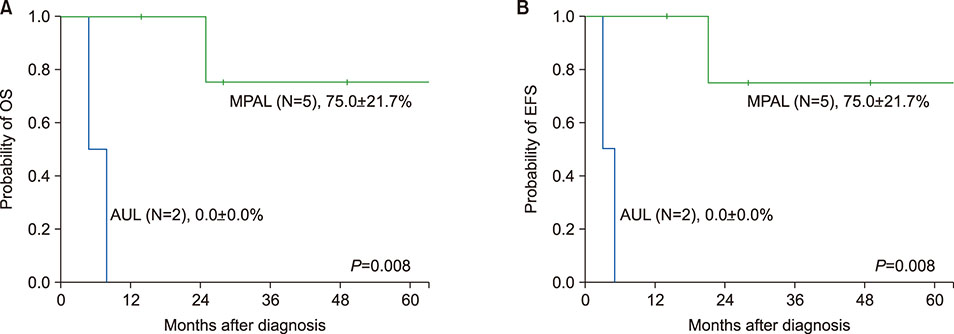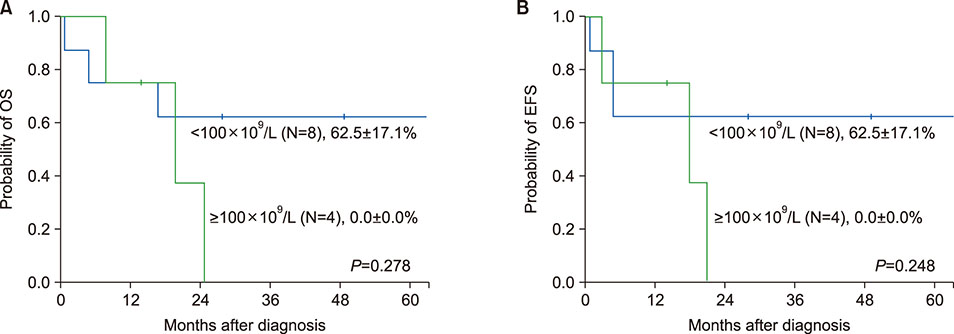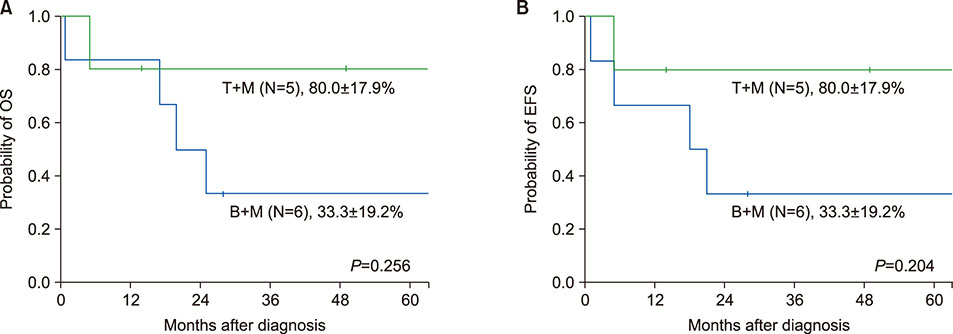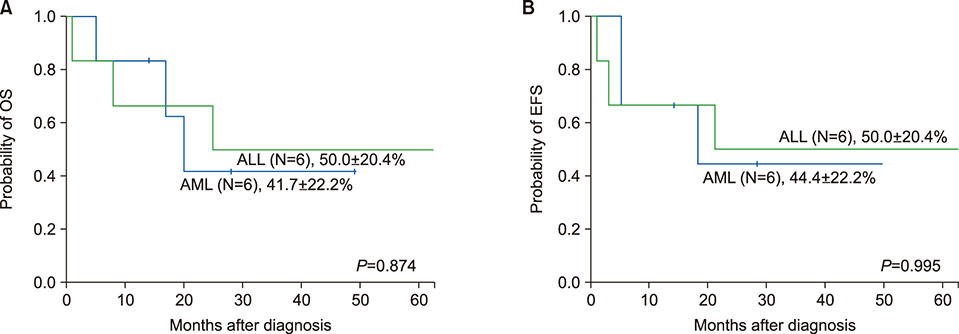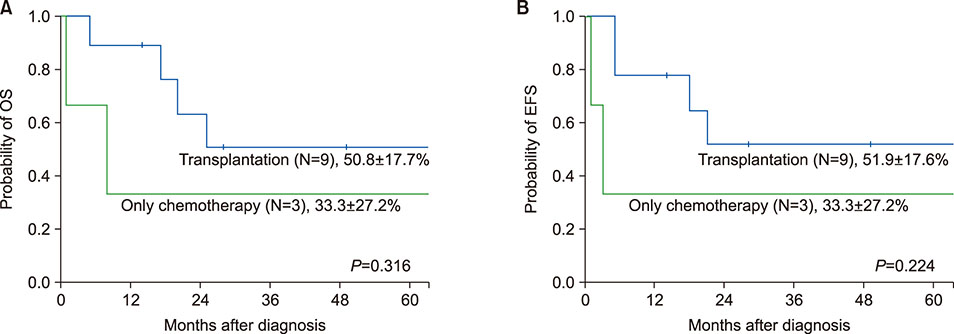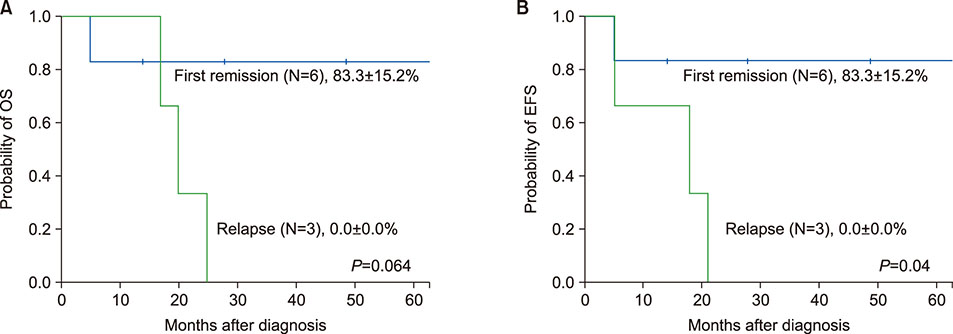Blood Res.
2019 Mar;54(1):63-73. 10.5045/br.2019.54.1.63.
Biphenotypic acute leukemia or acute leukemia of ambiguous lineage in childhood: clinical characteristics and outcome
- Affiliations
-
- 1Department of Pediatrics, Chonnam National University Hwasun Hospital, Chonnam National University Medical School, Hwasun, Korea. hoonkook@chonnam.ac.kr
- 2Environmental Health Center for Childhood Leukemia and Cancer, Chonnam National University Hwasun Hospital, Hwasun, Korea.
- KMID: 2451058
- DOI: http://doi.org/10.5045/br.2019.54.1.63
Abstract
- BACKGROUND
Acute leukemia (AL), not clearly assigned to myeloid, B-lymphoid, or T-lymphoid lineage, is classified as either biphenotypic acute leukemia (BAL) based on the European Group for Immunological Classification of Leukemias (EGIL) or acute leukemia of ambiguous lineage (ALAL) encompassing acute undifferentiated leukemia (AUL) and mixed-phenotype acute leukemia (MPAL) based on the World Health Organization (WHO) criteria.
METHODS
Medical records of children newly diagnosed with BAL or ALAL, based on the EGIL or the 2008/2016 WHO criteria, respectively, admitted at Chonnam National University Hospital in 2001-2017 were retrospectively reviewed.
RESULTS
Twelve (3.2%) of 377 AL patients satisfied the BAL or ALAL definitions based on the EGIL or the WHO criteria, respectively. Among 12 patients including 11 with BAL and another with undefined case based on the EGIL criteria, 7 (1.9%) had ALAL based on more stringent 2016 WHO criteria (AUL, 2; MPAL, 5). One patient had MPAL with t(9;22)(q34;q11.2), BCR-ABL+, and two had MLL gene abnormality. ALL-directed regimen was associated with better complete remission rate compared with AML-directed regimen (100.0% vs. 16.7%; P=0.015). The 5-year overall survival (OS) and event-free survival (EFS) were 51.1±15.8% and 51.9±15.7%, respectively. AUL was associated with poor OS and EFS compared with MPAL (0.0% vs. 75.0±21.7%; P=0.008).
CONCLUSION
Due to the rarity of the cases, future multicenter, prospective studies incorporating large number of cases are urgently warranted to identify the clinical, biologic, and molecular markers for the prediction of prognosis and determine the best tailored therapy for each patient.
Keyword
MeSH Terms
Figure
Reference
-
1. Béné MC, Porwit A. Acute leukemias of ambiguous lineage. Semin Diagn Pathol. 2012; 29:12–18.
Article2. Rubnitz JE, Onciu M, Pounds S, et al. Acute mixed lineage leukemia in children: the experience of St Jude Children's Research Hospital. Blood. 2009; 113:5083–5089.
Article3. Bene MC, Castoldi G, Knapp W, et al. Proposals for the immunological classification of acute leukemias. European Group for the Immunological Characterization of Leukemias (EGIL). Leukemia. 1995; 9:1783–1786.4. Matutes E, Morilla R, Farahat N, et al. Definition of acute biphenotypic leukemia. Haematologica. 1997; 82:64–66.5. Vardiman JW, Thiele J, Arber DA, et al. The 2008 revision of the World Health Organization (WHO) classification of myeloid neoplasms and acute leukemia: rationale and important changes. Blood. 2009; 114:937–951.
Article6. Arber DA, Orazi A, Hasserjian R, et al. The 2016 revision to the World Health Organization classification of myeloid neoplasms and acute leukemia. Blood. 2016; 127:2391–2405.
Article7. Killick S, Matutes E, Powles RL, et al. Outcome of biphenotypic acute leukemia. Haematologica. 1999; 84:699–706.8. Park JA, Ghim TT, Bae Kw, et al. Stem cell transplant in the treatment of childhood biphenotypic acute leukemia. Pediatr Blood Cancer. 2009; 53:444–452.
Article9. Lee MY, Tan TD, Feng AC. Clinicopathologic analysis of acute myeloid leukemia in a single institution: biphenotypic acute myeloid leukemia may not be an aggressive subtype. J Chin Med Assoc. 2007; 70:269–273.
Article10. Munker R, Labopin M, Esteve J, Schmid C, Mohty M, Nagler A. Mixed phenotype acute leukemia: outcomes with allogeneic stem cell transplantation. A retrospective study from the Acute Leukemia Working Party of the EBMT. Haematologica. 2017; 102:2134–2140.
Article11. Weinberg OK, Seetharam M, Ren L, Alizadeh A, Arber DA. Mixed phenotype acute leukemia: A study of 61 cases using World Health Organization and European Group for the Immunological Classification of Leukaemias criteria. Am J Clin Pathol. 2014; 142:803–808.12. Wolach O, Stone RM. How I treat mixed-phenotype acute leukemia. Blood. 2015; 125:2477–2485.
Article13. Charles NJ, Boyer DF. Mixed-phenotype acute leukemia: diagnostic criteria and pitfalls. Arch Pathol Lab Med. 2017; 141:1462–1468.
Article14. Matutes E, Pickl WF, Van't Veer M, et al. Mixed-phenotype acute leukemia: clinical and laboratory features and outcome in 100 patients defined according to the WHO 2008 classification. Blood. 2011; 117:3163–3171.
Article15. Gerr H, Zimmermann M, Schrappe M, et al. Acute leukaemias of ambiguous lineage in children: characterization, prognosis and therapy recommendations. Br J Haematol. 2010; 149:84–92.
Article16. Hrusak O, de Haas V, Stancikova J, et al. International cooperative study identifies treatment strategy in childhood ambiguous lineage leukemia. Blood. 2018; 132:264–276.
Article17. Al-Seraihy AS, Owaidah TM, Ayas M, et al. Clinical characteristics and outcome of children with biphenotypic acute leukemia. Haematologica. 2009; 94:1682–1690.
Article18. Carbonell F, Swansbury J, Min T, et al. Cytogenetic findings in acute biphenotypic leukaemia. Leukemia. 1996; 10:1283–1287.19. Owaidah TM, Al Beihany A, Iqbal MA, Elkum N, Roberts GT. Cytogenetics, molecular and ultrastructural characteristics of biphenotypic acute leukemia identified by the EGIL scoring system. Leukemia. 2006; 20:620–626.
Article20. Xu XQ, Wang JM, Lü SQ, et al. Clinical and biological characteristics of adult biphenotypic acute leukemia in comparison with that of acute myeloid leukemia and acute lymphoblastic leukemia: a case series of a Chinese population. Haematologica. 2009; 94:919–927.
Article21. Zhang Y, Tan L, Zhang X, Wei H, Hu Q. Clinical study of acute mixed-lineage leukemia in 14 children. Iran J Pediatr. 2011; 21:521–525.22. Mikulic M, Batinic D, Sucic M, et al. Biological features and outcome of biphenotypic acute leukemia: a case series. Hematol Oncol Stem Cell Ther. 2008; 1:225–230.
Article23. Wassmann B, Pfeifer H, Goekbuget N, et al. Alternating versus concurrent schedules of imatinib and chemotherapy as front-line therapy for Philadelphia-positive acute lymphoblastic leukemia (Ph+ ALL). Blood. 2006; 108:1469–1477.
Article24. Roberts KG, Li Y, Payne-Turner D, et al. Targetable kinase-activating lesions in Ph-like acute lymphoblastic leukemia. N Engl J Med. 2014; 371:1005–1015.25. Yan L, Ping N, Zhu M, et al. Clinical, immunophenotypic, cytogenetic, and molecular genetic features in 117 adult patients with mixed-phenotype acute leukemia defined by WHO-2008 classification. Haematologica. 2012; 97:1708–1712.
Article26. Lee JH, Min YH, Chung CW, et al. Prognostic implications of the immunophenotype in biphenotypic acute leukemia. Leuk Lymphoma. 2008; 49:700–709.
Article27. Kim HJ. Mixed-phenotype acute leukemia (MPAL) and beyond. Blood Res. 2016; 51:215–216.
Article28. Tian H, Xu Y, Liu L, et al. Comparison of outcomes in mixed phenotype acute leukemia patients treated with chemotherapy and stem cell transplantation versus chemotherapy alone. Leuk Res. 2016; 45:40–46.
Article29. Kim HN, Hur M, Kim H, et al. First case of biphenotypic/bilineal (B/myeloid, B/monocytic) mixed phenotype acute leukemia with t(9;22)(q34;q11.2);BCR-ABL1. Ann Clin Lab Sci. 2016; 46:435–438.30. Shi R, Munker R. Survival of patients with mixed phenotype acute leukemias: A large population-based study. Leuk Res. 2015; 39:606–616.
Article
- Full Text Links
- Actions
-
Cited
- CITED
-
- Close
- Share
- Similar articles
-
- A case report of adult acute biphenotypic leukemia-hand mirror variant
- A case of biphenotypic acute leukemia with expression of the AML1-ETO gene rearrangement
- A Case of Transient Pancytopenia Preceding Childhood Acute Leukemia
- A case of bullous pyoderma gangrenosum associated with refractory acute biphenotypic leukemia
- Expression of Granulocyte Colony-Stimulating Factor Receptor (G-CSFR) and Clinical Correlates in Acute Leukemia

